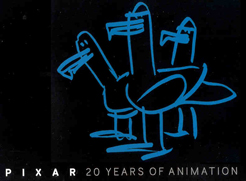Commentary &Pixar 14 Dec 2005 12:10 pm
PIXAR at MOMA 2
PIXAR at MOMA
The Museum of Modern Art has an extensive exhibition of artwork from the PIXAR films. Last night there was an official opening where a couple of hundred people were invited to eat sushi and sandwiches, drink martinis and wine and pore over the displays which sprawl over several rooms in the museum. The only animation people I recognized were Emily Hubley and Will Rosenthal, George Griffin and Karen Cooper, and Bill Plympton. The museum has scheduled several chat sessions upcoming with John Lasseter, directors, designers, and animators from PIXAR.
The artwork downstairs around the two theaters featured a lot of the original preproduction paintings and drawings (I recognized much of the work from the “Art of {film title here}†books released) they’ve produced for each of their films. I was surprised at how small most of it is. Few pieces seemed to expand beyond the animators’ desktop. That, of course, isn’t a negative; it’s just not what I anticipated.
Something else I didn’t anticipate was the “zoetrope†I’d read about in the New York Times. (I’m not sure this is actually a Zoetrope. It’s a stroboscopic effect as opposed to looking through slits spinning. I suppose that’s a moot comment.) Here were dozens of PIXAR dolls sculpted in 3D placed on a rotating table. It was encased in a large frame with several large windows through which you could see the rotation. The lights within the case strobed to create an effect of motion in the dolls. Because ambient lights in the room are dimmed, the dolls almost seem to be in deep shadow. It sounds somewhat similar to a device developed by Toshio Iwai in 1988. I didn’t find the work very thrilling when I first came upon it already in motion. Later, when I saw it still, with the room lit so you could see the details of all the little dolls, and the table began to spin counter-clockwise; then the lights dimmed and the stroboscope flashed, the group watching the display applauded because suddenly the dolls took on a motion. It became more impressive.
In the same room was a digital projection. The screen – a wall – was very wide and not very high. The program included motion projection of some of the work on display downstairs. Several pieces floated around each other and came to life when they filled this very wide screen. I found the wide-screen projection exciting. All those Cinerama movies in my childhood had an effect, I guess.
Most enjoyable, to me, was a projection of the skeletal framework for characters, props and backgrounds which animated around each other. It was thoroughly engrossing to watch.
I am wrestling with the “art†of all this preproduction material and would like to talk about it in another posting. I do know I was, once again, transfixed by the stunning Miro mural one had to bypass on the way to, past, and from the PIXAR exhibit. It made me want to get back to see more of the art upstairs. I will return soon.
strobe lights
build your own zoetrope
buy your own zoetrope $6.95

on 15 Dec 2005 at 12:10 am 1.Scott Carter said …
Brilliant show. The Zoetrope is fun, but it really is the original art that Pixar shared with the museum and the public that’s the thing. The great thing about what’s on view is following how far the ideas expand and contract on their way to the screen. More than any other studio (or frankly most animators at all), Pixar REALLY explores the subject before committing to it. Beautiful work and great show.
on 15 Dec 2005 at 12:51 pm 2.Daniel Chappelle said …
Are you allowed to bring a camera?
on 15 Dec 2005 at 4:10 pm 3.Daniel Chappelle said …
The MoMA website says they do allow cameras, but maybe there is small print about ‘Special Exhibits’
And it’s now SOLD OUT, even for MEMBERS of MoMA – which I am one.
Any one with a spare ticket feel free to email me at
madmanmagic@mac.com
dan
on 22 Dec 2005 at 7:19 pm 4.Jen said …
Backtracking again through your blog…I’m wondering: why were you suprised that the artwork was “small”? That is–in all my years doing development artwork in preproduction(including with Lou Romano, Mike Smith, Tony Fucile, Ricky Nierva, and Maurice Noble, all at Turner), none of the work produced was bigger than a desktop(most was no larger than 9×12, if that)…that would be pretty huge, wouldn’t it? I mean, that’d be larger than, say, a 24 field? As an animation artist yourself, I can’t figure why you’d think the Pixar artists would work larger than the average piece of paper size, or larger than a poster size?
on 27 Dec 2005 at 10:40 am 5.MS said …
If you look at artwork from some of the earlier Disey films, inspirational artwork oftentimes gets large. It isn’t going to be used in the photography of the artwork, so artists can work any size they want.
In my studio, artwork tends to be large early on, then it gets small. Of course, that depends on the individual artist working on it. The storyboard for the feature we’re slowly putting together has artwork in many different sizes. Some panels are 11×17 (and are reduced to put into a manageable storyboard).
PIXAR isn’t using any of this flat artwork for actual use in the film, it could have been any size the artist wanted. Somehow, I think this stifles creativity.